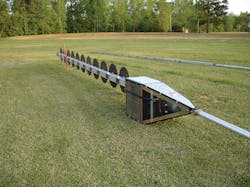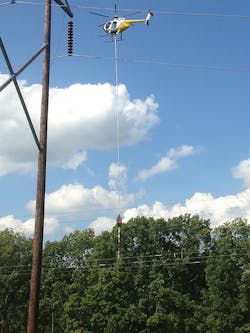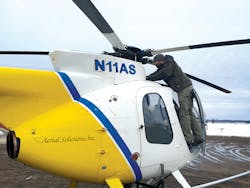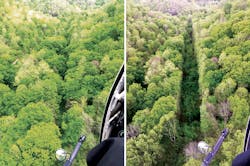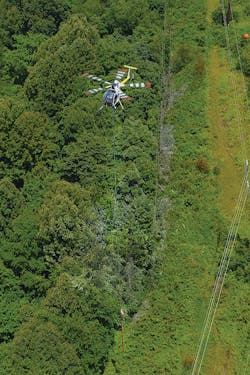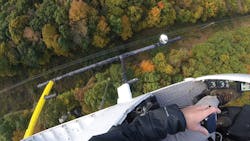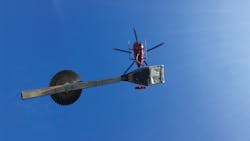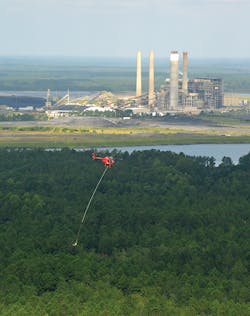Aerial Saw Is Boon to Line Trimming
"That’s crazy!” “That will never work.” These were the reactions of most utility personnel when the idea of side trimming trees by suspending a device with ten whirling saw blades under a helicopter was presented to them in 1985. At that time, most side trimming for electric utilities was done by climbing crews or mechanical trimmers working from the ground. Most utility vegetation managers were skeptical this concept would ever work.
As a result of the early skepticism, the owners of Aerial Solutions Inc. (ASI) faced an uphill climb in selling the concept. Because keeping the power flowing safely and efficiently are top priorities, some utilities elected to give ASI an opportunity to perform a pilot project on their lines. Most were pleasantly surprised to find the saw could remove lateral vegetation encroachment from ground to sky, providing them with a new tool to help keep the power flowing.
Fast-forward to today, and many utilities have now embraced the concept of trimming trees from a helicopter. They have found the technology works safely and efficiently, particularly in mountainous terrain, rural locations, wetlands and sensitive areas where environmental or regulatory issues are encountered. Today’s aerial saw design consists of ten 2-ft-diameter blades attached to a 90-ft aluminum boom. A 28-hp engine powers a series of belts that turn the blades at 4,000 rpm, which the pilot remotely controls from the helicopter. ASI designed a bracing system that keeps the saw from twisting under the MD 500 helicopter from MD Helicopters Inc.
Trimming work is completed by flying above and along the power line right-of-way, cutting the lateral vegetation. Generally, more than one pass is needed to provide adequate clearance depending on the height and density of the vegetation. On average, 20 miles of transmission lines and 10 miles of distribution lines can be cleared in a six-day workweek.
Extensive Regulations
Aerial saw operations must maintain compliance with U.S. Federal Aviation Administration (FAA) regulations, which are governed under FAR Part 91 and Part 133. To comply with these regulations, ASI has developed specific safety and operation procedures that must be approved by the FAA. Part 91 (General Operating and Flight Rules) provides guidance on all aspects of flight operations such as airworthiness, airspace rules, required equipment and maintenance. Part 133 (Rotorcraft External Load Operations) provides guidance on operating with an external load, requirements for certifications, training, emergency operations and operating limitations. To ensure compliance, the FAA performs both on-site and field inspections.
Pilots must receive special FAA certification to perform external load operations. In addition, ASI has developed many modifications to its helicopters to ensure safe operation. These modifications can be employed only after undergoing the FAA certification process, which includes engineering, a stress test, a flight test and administrative approval.
Aircraft must be maintained in accordance with specific FAA and manufacturer’s guidance; ASI’s maintenance program meets and exceeds these guidance sources. All mechanics hold airframe and power plant (A&P) and inspection authorization (IA) mechanics certification. Mechanics perform inspections every 100 hours of flight time and a more in-depth inspection is completed every 300 hours.
AEP and Early Adopters
American Electric Power (AEP) began contracting the use of the aerial saw in 1986. The saw was used initially on transmission lines in Virginia, West Virginia, Kentucky and Tennessee, where the transmission footprint features various challenging terrain. A variety of specialized equipment is used in these areas, but the AEP forestry staff has found the aerial saw is one of the most efficient. The aerial saw works well in remote locations and can cover a lot of ground in an expedited manner.
Currently, the saw is a key component of AEP’s program to maintain transmission and distribution right-of-way corridors throughout its 11-state service area. AEP personnel have seen a substantial time and cost reduction per mile, and the utility’s system average interruption frequency (SAIFI) numbers have dropped significantly. In addition, the need for line-clearance ground crews to climb trees has been decreased, benefiting worker safety and lowering the risk on AEP’s system. Vendor-caused interruptions have been reduced, as well.
Most of the transmission vegetation-related issues are attributable to trees along the edges of the right-of-way. Trees naturally grow into the open space and must be trimmed back to maintain a safe minimum vegetation clearance distance (MVCD) along transmission corridors. This is particularly important because of the North American Electric Reliability Corporation’s vegetation management standards, which require the MCVDs to be maintained at all times or the utility risks significant fines. Using the aerial saw enables AEP to meet this challenge in a safe and cost-effective way while freeing up limited contract crew resources for more hands-on work.
AEP’s distribution personnel find the ability to clear miles of overhanging and side-encroachment vegetation in remote and rural locations in a short time period has kept the utility’s program on track and within budget. A four-year cycle was instituted on the Ohio distribution system, and the aerial saw was a key component in helping to keep the program on schedule.
Other utilities have similar opinions on the use of the aerial saw. Rebecca Spach, director of vegetation management at FirstEnergy, said the aerial saw improves access and the ability to inspect the utility’s transmission right-of-way.
“Unlike traditional methods, aerial trimming can reach from the ground to the very top of the tree, without being limited by the reach of a ground vehicle,” Spach said. “Using the aerial saw protects private land and roads from damage by heavy equipment making repeated trips during the course of the work schedule.
“Normal pruning occurs once every five years,” Spach added. “However, by using the aerial saw, we anticipate pruning cycles can be extended to eight years or greater.”
Similarly, Mary Hetz, manager of vegetation management for transmission at Ameren Corp., shared that her company has experienced positive results, as well.
“Aerial trimming is an effective tool in maintaining vegetation in rural and remote locations,” Hertz said. “The amount of trimming an aerial saw can complete in a short period of time minimizes the amount of foot and vehicle traffic that otherwise would be needed with a climbing crew or an all-terrain aerial bucket crew traversing the area for a much longer period of time. It improves access and our ability to visually inspect our transmission right-of-way.
“It’s critical that utility contractors be focused on safety, training and customer service, and this has been our experience with aerial trimming,” Hertz said.
Safety Core Value
One of the first questions people ask when first learning about the aerial saw concerns safety. Safety is highly important because helicopters must pick up more than 800 lb every time the chopper takes off. Thanks to intense training during the first year for new pilots and recurrent annual training for all pilots, safety has become a core value of ASI employees. The company has flown more than 140,000 hours since its inception in 1985. Field personnel have had no lost-time incidents in the last three years, and ASI’s experience modification rate is 0.74, well below the aviation industry average.
To protect the public and ground-based vegetation management personnel, ASI has developed an FAA-approved protocol. Only ASI and other personnel who have passed a safety training course are allowed within 200 ft of the saw while it is in use. People living near the power line right-of-way are notified in advance of the work, and if a house is within 200 ft, work within that area will only be completed if the homeowners are willing to leave the house during the operations. Likewise, work within 160 ft of highway crossings is stopped unless traffic control measures have been taken.
“What happens if the saw gets stuck in a tree limb?” is another frequently asked question. While this rarely happens, ASI has developed a set of procedures in the event of a hang up. First, the pilot attempts to maneuver the ship so it helps to pull the saw from the tree. If unsuccessful after several attempts, the pilot ensures the area surrounding the saw is clear of people, and then the saw is either released manually or electronically by the pilot.
Summing Up
While not applicable everywhere, such as in urban areas, aerial saw operations offer utilities many advantages:
- Safety. While many ground personnel are required to remove lateral encroachment, aerial saw crews only use two people, thereby greatly reducing the exposure to safety incidents.
- Improved service reliability. Trimming trees away from power lines reduces the potential for vegetation-related outages and operations. Aerial trimming is not limited by the reach of a ground vehicle as it can trim from the ground to the tops of the trees.
- Cost effectiveness. Most utilities report significant cost savings versus ground-based crews when using the aerial saw. Estimates range from 20% improvement at FirstEnergy to as much as 87% in some instances at Entergy.
- Time savings. On average, helicopter crews can trim between 1.5 miles per day to 3 miles per day — much faster than ground-based crews. American Transmission Co. personnel say it would take a crew one week to complete the same amount of work that could be accomplished with the aerial saw in an hour.
- No terrain limitations. The saw can be airlifted into remote locations that are difficult and time-consuming to access using ground-based resources.
- Mobility. The saw and support vehicle can be moved quickly from line to line versus the need to transport ground-based crews and equipment across the country.
- Environmental impacts reduced. The aerial saw can access wetlands and other sensitive areas without causing harmful environmental damage. Roads are protected from damage that can occur when heavy equipment makes repeated trips during the course of the work schedule. ASI has used the saw successfully on 11 national forest properties where it is vitally important to avoid soil compaction, erosion and other environmental issues.
Many of the early skeptics of the aerial saw have since found this tool to be safe, efficient and effective for line clearance. Usage of the tool continues to grow as it is can be effective with both distribution and transmission lines. Walter Sherry, former AEP forestry manager, stated, “Since the inception of the aerial saw, it has been and will remain an invaluable resource in AEP’s efforts to maintain reliable electric facilities.” ♦
Rick Mowbray is the transmission forestry supervisor for American Electric Power, located in Roanoke, Virginia. With a staff of six field foresters, he manages approximately 9,000 miles of transmission lines in Virginia, West Virginia, Kentucky and Tennessee. He is a graduate of Virginia Tech in Blacksburg, Virginia, and has been active in utility vegetation management for 32 years.
William C. (Cleve) Cox IV is president and chief pilot for Aerial Solutions Inc., a family-owned business located in Tabor City, North Carolina. He received his advanced fixed wing training at Comair Aviation Academy in Florida and later added his commercial helicopter rating. The company, which owns 10 helicopters, eight of which perform aerial saw work, trimmed approximately 5,500 miles of transmission and distribution lines for 14 utilities in 2016.
Sidebar: Utilities Embrace Aerial Topping Saw Operations
By Kristin Wild, Asplundh Tree Expert Co.
In late 2015, South Carolina Electric & Gas (SCE&G) identified heavy concentrations of dead trees in a secured area that needed to be addressed in a timely manner. At the very least, removing the tops of the dead trees was needed to clear the line and mitigate the hazard.
Aerial sawing is a well-known tool in SCE&G’s vegetation management toolbox, having contracted this work for more than 30 years. Charles Moore, general manager of system operations for SCE&G, decided to contact one of the utility’s aerial sawing contractors — Rotor Blade LLC, based in Pawleys Island, South Carolina — to see if the company could modify a saw to cut just the top out of the trees using a helicopter. In response, Ashley Haddock of Rotor Blade and his team quickly designed and fabricated an aerial topping saw prototype. The design was refined after initial testing, and pilots soon perfected their topping saw techniques on the SCE&G system.
Operational Metrics
Since late 2015, Rotor Blade’s Tree Topper Saw has been in use on at least seven investor-owned and cooperative utilities’ power lines, primarily on rural distribution lines. Although contract specifications vary from utility to utility, it is generally being used to safely and efficiently lower the height of dead, dying or storm-damaged trees so that any potential fall-ins will clear the line.
Currently, aerial topping saw operations fall into two application methods. In the first method, the helicopter pilot and ground crew follow a transmission or distribution line out from a substation, identifying and mitigating the high-risk trees as they go. The work is generally done when the leaves are still on the trees so the pilot and ground crew can distinguish the dead from the living trees. In the second method, GPS coordinates for high-risk trees are provided by the utility based on a routine or post-storm aerial patrol of a transmission line. The Tree Topper Saw crew simply flies to each location, tops the tree and moves on. It can take as little as one minute to top the tree.
With both methods, the number of trees per hour is directly influenced by the distance between locations, but it is often less expensive, quicker and safer than deploying ground crews. A mechanical side-trimming machine may be price competitive with the Tree Topper Saw, but only if the access, terrain, size of the trees and other site considerations are not problems for the machine. Depending on the tree density along the right-of-way, the Tree Topper Saw can mitigate more than 100 trees per day. The largest cut to date is 33 inches in diameter at the cut.
On a recent project for AEP Ohio, approximately 3,500 trees were topped with an average of 45 trees cut per hour of flight time (not including set up and ferrying time). However, the average was about 22 trees cut per hour on a smaller project for Guernsey-Muskingum Electric Cooperative in early March of this year. Roughly 450 emerald ash borer-killed trees were topped in approximately 20 hours of flying time along a 12-kV line traversing a state park near Zanesville, Ohio. Pre-planners had marked the trees with ribbon, which helped the Rotor Blade pilot and ground crew identify the dead trees in the winter. This method proved to be at least 25% less expensive than ground crews at this location.
One thing to take into consideration on rights-of-way with insect-infested or diseased trees is the fact that once the Tree Topper Saw gets on location, there are often more dead trees than first observed by the utility or a contracted risk-assessment team. Contract specifications should be clear about discretionary topping and how this additional work should be documented for invoicing.
Mitigating Risk Quickly
With an increasing number of dead or dying trees affected by pine beetles, emerald ash borer, droughts and wildfires, the aerial topping saw is an efficient way to mitigate the risk to transmission and distribution lines, no matter what the terrain is like. This vegetation management tool also reduces worker exposure to hazardous dead tree removal conditions and difficult off-road terrain. Aerial topping saw operations leave no footprint in sensitive areas, unless a follow-up tree or debris removal crew is needed to meet customer or public service commission requirements.
Editor’s note: For more information about the patent-pending Tree Topper Saw, contact Steve Bostock at Rotor Blade LLC. A video of the topping saw in action can be viewed at www.rotor-blade.com.
About the Author
Rick Mowbray
Transmission Forestry Supervisor
Rick Mowbray is the transmission forestry supervisor for American Electric Power, located in Roanoke, Virginia. With a staff of six field foresters, he manages approximately 9,000 miles of transmission lines in Virginia, West Virginia, Kentucky and Tennessee. He is a graduate of Virginia Tech in Blacksburg, Virginia, and has been active in utility vegetation management for 32 years.
William C. Cox IV
President and Chief Pilot
William C. (Cleve) Cox IV is president and chief pilot for Aerial Solutions Inc., a family-owned business located in Tabor City, North Carolina. He received his advanced fixed wing training at Comair Aviation Academy in Florida and later added his commercial helicopter rating. The company, which owns 10 helicopters, eight of which perform aerial saw work, trimmed approximately 5,500 miles of transmission and distribution lines for 14 utilities in 2016.
